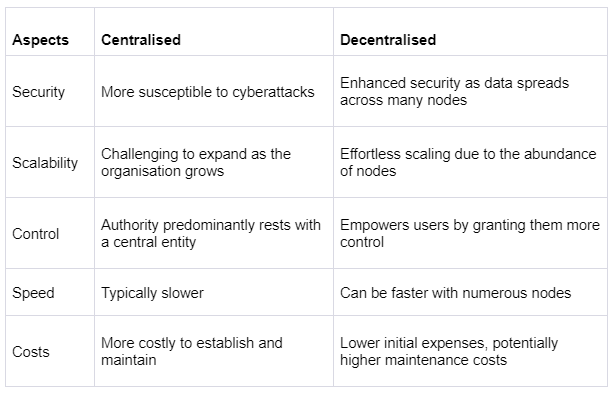Centralised vs Decentralised Systems: Navigating the Crypto World
Introduction
Ever found yourself curious about what sets centralised and decentralised systems apart? Wondering how these ideas play a role in both the business world and the realm of cryptocurrency? Let's unravel the intricacies together!
What Is Centralised?
Centralised systems, both in traditional organisations and the digital landscape of cryptocurrencies, are akin to a centralised command centre. Imagine a single leader or a specific location where all the major decisions and planning activities take place. It's like the heart of an operation, where the power to make crucial choices resides.
In centralised organisations, decision-making authority is firmly rooted in the central office. Every directive, every strategy, and every important call stems from this core location. Branch offices, akin to branches of a tree, receive their instructions directly from the headquarters, ensuring a unified approach in the organisation's endeavours.
For instance, in centralised governance structures, decision-making authority is concentrated at the top. Every level below follows the directives issued from the summit of the organisational hierarchy. This top-down approach ensures a clear chain of command, allowing decisions to be executed swiftly and uniformly across the organisation.
Examples of Centralized Systems in Organizations
To illustrate the concept of centralized systems within organizations, consider the retail business as a prime example. In this scenario, a centralized structure manifests itself as a framework where senior managers operating from the headquarters play a pivotal role in shaping crucial decisions, such as product pricing and inventory management.
For example, in a retail business, these senior managers stationed at the heart of the operation have the authority to set the pricing strategy for products across all the stores, ensuring a uniform and cohesive approach. Moreover, they oversee inventory management, determining what products are stocked, where, and in what quantities, optimizing the supply chain to meet customer demands.
Example of Buying and Selling Cryptocurrency
In the realm of cryptocurrencies, centralized systems are found in the operations of centralized exchanges. These exchanges function as intermediaries where buyers and sellers trade various cryptocurrencies. For instance, let's explore buying and selling Bitcoin on a centralized exchange:
Buying Bitcoin: As a buyer, you initiate the process by creating an account on a centralized exchange platform. You deposit your desired currency, like USD or MYR, into your exchange account. The exchange matches you with a seller who is offering Bitcoin at your desired price. Upon agreement, the exchange facilitates the transaction, and the Bitcoin is credited to your exchange account.
Selling Bitcoin: When you wish to sell Bitcoin, you deposit your Bitcoin holdings into your exchange account. The exchange matches you with a buyer interested in purchasing Bitcoin at your specified price. Upon agreement, the exchange ensures the transaction's execution, and you receive your chosen currency in your exchange account.
In these exchanges, the centralized structure takes responsibility for facilitating the transactions, providing a platform for users to trade, and overseeing the security and regulatory compliance of the process.
Advantages of Centralized Systems
Clear Chains of Command: In centralized systems, everyone knows whom to report to. This streamlined hierarchy facilitates swift and consistent decision execution.
Focused Vision: Organizations with a centralized structure can easily concentrate on achieving their vision. All stakeholders receive uniform messages and align with a shared goal.
Cost Reduction: Centralized systems follow standardized procedures, which can lower administrative costs.
Disadvantages of Centralized Systems
Bureaucratic Process: Centralized systems can cause bureaucratic process, where employees become mere executors of decisions made by top executives.
Remote Control Issues: Remote branches may encounter difficulties when attempting to implement decisions from the central office, potentially causing inefficiencies.
Work Delays: Due to the need to communicate decisions to and from the central office, work processes can slow down, leading to delays in operations.
High Cost: As there are layers of bureaucracy, it often results in higher cost to the business.
Centralization in the World of Cryptocurrency
In contrast to the common presence of centralized systems in traditional organizations, the realm of cryptocurrency is all about decentralization. An excellent example is Bitcoin's blockchain, which epitomizes the concept of decentralization.
Exploring Decentralization
Decentralization is at the heart of the crypto world. It represents a fundamental shift towards transparency and security. In decentralized systems, data cannot be tampered with or manipulated easily. This, in turn, cultivates trust among users.
In a decentralized environment, power is distributed across a network of participants, each contributing to the system's integrity. As a result, blockchain technologies, like that of Bitcoin, ensure that once data is recorded, it remains unchanged, fostering trust and transparency among users.
Distinguishing Centralised vs. Decentralised
Now, let's break down the key differences between centralised and decentralised systems in a way that's easy to grasp, with a focus on security, scalability, control, speed, and costs.
In this simplified comparison, we'll clarify how these two systems differ, ensuring you understand their implications in various contexts.
Understanding the Crypto Exchange Landscape
When you venture into the exciting world of cryptocurrency trading, it's vital to grasp the distinction between centralized and decentralized exchanges.
Centralized Exchanges: These exchanges, operated by a single entity, serve as the middlemen for all your cryptocurrency transactions. They facilitate the buying and selling of various cryptocurrencies and are a popular choice for many traders.
In a centralized exchange, you interact with a platform that is under the control of a specific company or organization. This entity manages your trades, stores your funds, and ensures compliance with regulations.
This understanding of the centralized exchange landscape is essential for anyone looking to dive into the crypto trading world, offering clarity and insights that can guide your trading decisions.
Why Knowing the Difference Matters in Crypto Trading
Comprehending the distinctions between centralized and decentralized systems in the crypto landscape holds significant importance. It equips you with the knowledge needed to make smarter investment choices and harness the benefits unique to cryptocurrency trading.
Informed Investment Decisions: Understanding the contrast between centralized exchanges (where transactions are managed by a single entity) and decentralized platforms (where power is distributed among users) empowers you. It enables you to assess risks and rewards, allowing for well-informed investment decisions.
Leveraging Crypto Trading Advantages: Knowing the difference between centralized and decentralized setups helps you leverage crypto trading's advantages. Decentralized systems offer transparency, ensuring your trades are transparent & fair. Centralized exchanges, on the other hand, might offer more user-friendly interfaces, ability to transact with FIAT such as USD & MYR, and swift transactions, catering to different trading preferences.
By grasping these nuances, you can optimize your crypto trading experience, making the most of the dynamic crypto market and potentially maximizing your investments.
Conclusion
To sum it up, understanding the distinction between centralized and decentralized systems holds vital significance, bridging the worlds of business and cryptocurrency. This comprehension empowers you to make decisions with clarity and confidence, unlocking the unique advantages of crypto trading.
We trust that this information has been valuable to you, equipping you with the knowledge needed to navigate the ever-evolving landscapes of business and cryptocurrencies.
DISCLAIMER & WARNING
The information provided here is presented "as is'' and is intended for general informational and educational purposes only. It does not come with any representation or warranty of any kind. This content should not be interpreted as financial, legal, or other professional advice, and it is not intended to endorse or recommend the purchase of any specific product or service. It is advisable to consult with appropriate professional advisors for personalised guidance. In cases where the article is contributed by a third-party author, please note that the expressed views belong to the author alone and may not necessarily reflect the opinions of Hata. For furthedetails, we encourage you to read our complete disclaimer. Please be aware that the prices of digital assets can be highly volatile. The value of your investment may increase or decrease, and there is a risk that you may not recover the full amount invested. You are solely responsible for making your own investment decisions, and Hata cannot be held liable for any losses you may incur. This material is not to be construed as financial, legal, or other professional advice. For more information, please refer to Hata’s Terms of Use and Risk Warning.




